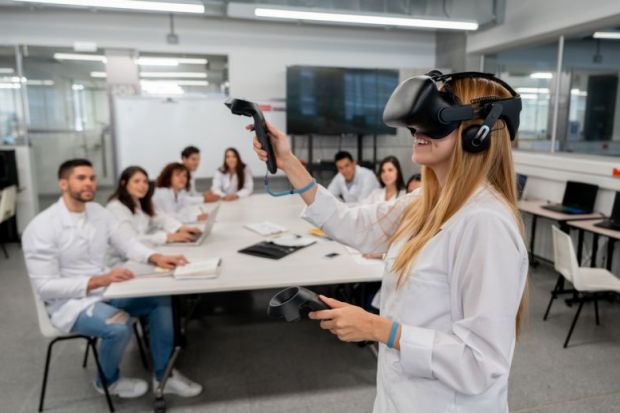The hype around augmented and virtual reality (AR and VR) – the wonders that it will provide for home entertainment, as well as how it could revolutionise training for industry and engineering – has extended to the education sector. AR and VR is now synonymous with the “classroom of the future”.
AR and VR is everywhere, from adverts featuring students wearing headsets with a look of awe on their faces to former UK education secretary Damian Hinds imploring us to think of how it could transport students to significant points in history, or enable them to explore the forest floor from the comfort of their classroom.
While that does all sound revolutionary, how realistic is it that this vision will come to life in the near future and exactly as imagined? Is it worth the cost and resource that it will take to implement?
A recent Jisc report included a survey of more than 100 lecturers, researchers and learning technologists at universities and colleges, which indicated that 82 per cent of the respondents are “interested” in VR or AR. Tellingly, however, there were no examples of how VR or AR was actually being used or how these respondents were planning to use it in the future. Why should we invest in technology that is very much wanted, but not altogether yet needed?
Don’t get me wrong, there are simple pre-made games and learning tools that are fun for younger children in primary and secondary school. But I question how this will translate to HE and FE environments when, at this point, the software isn’t available for a lecturer to easily get the full experience they are hoping for.
A history lecturer who wants to enhance learning about ancient Rome by transporting students to that time period, for examples, would have to think about the design of the programme and how to implement a bespoke project. It’s not as easy as just downloading an app onto a VR headset. The gulf between having the idea, to actually implementing that experience, is huge.
University IT departments are a long way from supporting that bespoke creation of VR experiences. Generally, they’re facing significant challenges in doing more basic stuff.
As a rule of thumb, it’s best not to adopt technology while it’s still in its relative infancy, simply because it is often expensive and there are still a lot of issues that need to be ironed out. iPhones are a key example of this: 13 years ago when the first model was released, no one would have suggested that every student in a classroom should and could afford to have one. Today, we think nothing of students using them as learning tools. I believe that immersive technologies will likely follow a similar path, but that by no means assures their long-term success in the education sector.
Further to this, the Jisc report suggested that rather than being widespread throughout organisations, immersive tech seems to be embedded in institutional silos, with 54 per cent of respondents suggesting that if they have the tech, it is mostly used in just one or two departments, further indicating that there needs to be a better understanding of how VR and AR can positively impact education.
In the HE and FE sector specifically, many issues are preventing students from achieving their best results and having the most valuable experience during their time at college or university. The money that is being poured into immersive headsets would at this time be better channelled into other areas of technology, which will have far great impact on student outcomes.
Mobile technology, for example, is continuing to offer opportunities for students to work remotely, and with a bit more investment, it could flourish into something much more accessible. It also feeds into the area of assessments, which are in dire need of review. Great strides have been taken to improve online examinations, which have the potential to widen participation among under-represented student groups, by enabling exams to be taken offsite and at different times.
In terms of the bigger picture, the potential for technology to completely innovate the way we learn as a society is infinite. There is a framework there to build an online marketplace where people of any ability or age can pick out learning resources and be allowed more flexibility when taking assessments. We’re just at the beginning of a journey that will see the sector transformed.
Immersive technologies may or may not have a role in that transformation. We may reach the stage where everyone has AR glasses, in the same way everyone has a smart phone. And indeed in other industries, AR and VR has already proven valuable, particularly for training.
However, if we fall too hard and too fast for immersive technologies in the classroom, we may see it become a solution without a problem.
Dave Kenworthy is director of digital services at CoSector, University of London.
Register to continue
Why register?
- Registration is free and only takes a moment
- Once registered, you can read 3 articles a month
- Sign up for our newsletter
Subscribe
Or subscribe for unlimited access to:
- Unlimited access to news, views, insights & reviews
- Digital editions
- Digital access to THE’s university and college rankings analysis
Already registered or a current subscriber? Login



